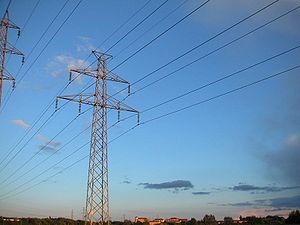
- Image via Wikipedia
Although the U.S. electric power industry is one of the greatest engineering marvels of the 20th century, aging technology and an increase in demand create problems for the electricity infrastructure that need to be fixed.
Venkat Selvamanickam, director of the Applied Research Hub and the M.D. Anderson chair professor of the department of mechanical engineering, University of Houston, is developing a technology with high temperature superconducting wires that is revolutionizing the way power is generated, transported and used.
“The country’s electric transmission grid currently consists of about 160,000 miles of high-voltage transmission lines, with forecasters predicting an additional 12,900 miles needed over the next five years to meet increasing demand,” said Selvamanickam. “The goal of my research is to modernize the power grid with high temperature superconducting wires to improve efficiency and reliability. Almost anything in the power grid- cables, transformers, motors, generators — can be more efficient if you use high temperature superconducting wires. Superconducting power cables can transmit up to 10 times more power than traditional copper cables without the significant losses of traditional cables and are considered environmentally friendly. Superconducting fault current limiters can enable uninterrupted power transmission when conventional circuits will otherwise succumb to outages in events such as lightning storms.”
On a tour of Selvamanickam’s research laboratory at Texas Center for Superconductivity at the University of Houston, he demonstrates different samples of the high temperature superconducting wire that resemble a shiny, metal tape about the size of a hair ribbon, with similar flexibility. The tape has six to eight layers with a ceramic-middle, one-hundredth as thick as human hair, consisting primarily of a coating made from a mixture of yttrium barium copper oxide, generally called YBCO (pronounced IB-co).
High temperature superconductivity defines certain materials like metals and ceramics that lose electrical resistance when cooled by liquid nitrogen, an inexpensive industrial refrigerant that costs less than a bottle of water, a major development in the price point for superconductivity for wide commercial use.
Without this resistance, electrons can travel through these materials freely, leading to wires fabricated into power cables that carry large amounts of electric current for long periods without losing energy as heat. Cooled by liquid nitrogen, high temperature superconducting wires reduce risk of explosion in that it’s not flammable.
The applications for high temperature superconducting wire range from advanced medical imaging techniques like magnetic resonance imaging (MRIs) to large-scale applications replacing existing copper wires with superconducting wires to raise reliability and cut costs in electric power transmission and distribution, storage devices, motors, generators, cellular communication systems, to magnetically-levitated trains.
“High temperature superconductivity has the potential to revolutionize the way we use electricity, just like the way fiber-optics revolutionized the way we communicate,” said Selvamanickam. “Our research pays immediate returns to the industry. It’s not like something that maybe 10 years down the line could be useful.”
Related articles by Zemanta
- Researcher modernizes US power grid (scienceblog.com)
- Quebec scientist unlocks superconductivity movement mystery (canada.com)
- Blog – Doped Graphane Should Superconduct at 90K (technologyreview.com)
- Superconductors on the nanoscale (scienceblog.com)








![Reblog this post [with Zemanta]](http://img.zemanta.com/reblog_b.png?x-id=3d169ed3-568f-4952-b4ac-125068d73dfc)
